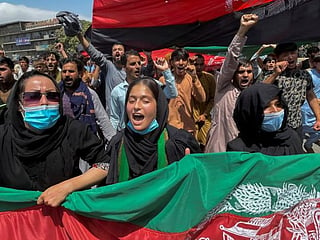Wrong to blame Afghans for Taliban takeover of Kabul
Americans completely failed to appreciate the culture and complexity of Afghanistan

With the Taliban’s return to power in Afghanistan after 20 years, a part of history has taken a full circle. While it is useful to identify causes of America’s defeat, the political elite need scapegoats for point scoring. Ironically though, America still insists in claiming victory over a historic blunder, which great powers make in process of their implosion.
During these two decades of ‘forever war’, America lost its way. These are the decades when America, which continues to be source of so much good in the world by way of education, sciences, technological innovation, chose to woefully succumb to what President Dwight Eisenhower warned was the “military-industrial complex.”
These are the decades when China has come of age to challenge American primacy. For ten years after the US achieved its objective of bringing Osama bin Laden to justice, it continued to destroy Afghanistan.
The real numbers may never be known but the estimates vary between 250,000 t0 300,000 civilians killed during the 20-year period. Why did America make the morally repugnant choice?
America’s declared objectives have also shifted by the year. Women’s rights in Afghanistan, which the US champions now were actually sponsored by the Soviet installed government in 1979 as part of the plan to modernise the Afghan society. And this modernisation attempt by the Soviets was exploited by the Cold War American leadership.
Beseeching false Islamic values, the US and its allies went on to sponsor radicalism through ‘madrassah (s)’ — a small mosque run school, set up among the millions of Afghan refugees in Pakistan.
These ‘Mujahideen’ — holy warriors — are the forerunners of Taliban, the more militant Daesh or other groups that promote radicalism elsewhere. With roles reversed, support for Afghan women now seems both hollow and mischievous.
The Najibullah regime, which the Soviets left behind while departing Afghanistan in February 1989, fought off the ‘Mujahideen’ challenge for three years. I am on record writing several times that America’s ‘quisling’ regime may not last that long.
Admittedly, like millions of others I was surprised too that the 300,000 strong Afghan National Security Force (ANSF) that the Americans spent nearly $80 billion raising, training and arming, folded within three weeks. Refusing to go deeper into causes of collapse of the regime, America and its allies blame the ANSF.
The fact is that ordinary Afghans did not accept the indignity of occupation and American intrusions into their homes in search of alleged Taliban. No wonder Alexander the Great warned in 302BC “ … beware of the revenge of an Afghan.”
The sequence of events underscores the fact that the regime had no public support. Calling them ‘insurgents’ was wrong. How could a man be an insurgent in his own country, resisting a foreign occupation?
The occupation and the regime survived through buying off hundreds and thousands of Afghans who enriched themselves through collaboration with the Americans.
The most recent report from the Special Inspector General for Afghanistan admits that: “US officials often empowered power brokers who preyed on the population or diverted US assistance away from its intended recipients to enrich and empower themselves and their allies …”
Ordinary Afghan have stayed back and want to participate in rebuilding of their battered country. Azmat Khan, a young Afghan journalist who has stayed back, tweeted last week that “many young people in rural battlefields have never experienced life without war” adding that “it might be hard to understand, but some youth feel they have a shot at a future now.”
Kishore Mahbubani, Distinguished Fellow at the Asia Research Institute, National University of Singapore, a former top diplomat and a prolific writer believes that there are three reasons why the regimes promoted by the US collapsed as soon the Americans withdrew.
The American habit of ‘control’ is one of the reasons of collapse. The ANSF resisted the Taliban reasonably well till the time US commanders were embedded with the ANSF to take decisions. As soon as the Americans left, the ANSF collapsed. The second reason is “culture” which the Americans were unwilling to appreciate.
With only 1.8 millions of 9.7 million voting in the presidential election, the so-called democracy experiment was never legitimate. The Afghan governance culture is based on ‘Jirga’ — an assembly of elders, wise men and not on one man one vote.
The consequences of pushing through an alien system was ballot rigging, vote buying and illegitimate. The third factor is American failure to ‘compromise’ and adapt the local culture and institutions in managing the occupation.
America could have wisely sought support from neighbours like Pakistan and Iran with almost identical culture, to help reshape Afghanistan. But the belief in its military prowess disallowed the US to seek out. Instead it attempted to impose its own writ, hence the monumental failure.
It would therefore be a huge mistake for Americans to blame the Afghans, who are the victims of mistakes made in Washington. That is exactly where the serious reflection has to take place.
Sajjad Ashraf served as an adjunct professor at the Lee Kuan Yew School of Public Policy, National University of Singapore from 2009 to 2017. He was a member of Pakistan Foreign Service from 1973 to 2008 and served as an ambassador to several countries.
Sign up for the Daily Briefing
Get the latest news and updates straight to your inbox






